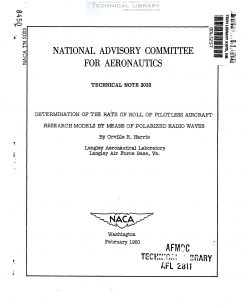naca-tn-2023
- Version
- 92 Downloads
- 698.67 KB File Size
- 1 File Count
- December 14, 2016 Create Date
- December 14, 2016 Last Updated
National Advisory Committee for Aeronautics, Technical Notes - Determination of the Rate of Roll of Pilotless Aircraft Research by Means of Polarized Radio Waves

A method is presented for determining the rate of roll of free-
flight aerodynamic models by means of polarized radio waves. A dis?
cussion of the technique used and a description of the equipment are
included. The discussion shows that through the use of this technique
the direction of roll, as well as zero roll, is uniquely determined.
Analysis of the data obtained and data accuracy are discussed and
examples are given to show how the recordrreduction method affects the
accuracy of the data. In conclusion, a method for increasing the
accuracy and reducing work-up effort is discussed.
The National Advisory Committee for Aeronautics has adopted an
aerodynamic research technique, for investigations in the supersonic
speed range, which utilizes free-flight rocket-powered aerodynamic test
vehicles. In seme of the investigations conducted by this method, such
as those for determining control effectiveness, some means for measuring
the rate of roll of the model in flight was required. Existing methods
of measuring spin, such as used for determinations of artillery-shell
spin decay (reference 1) were not suitable. Excessive errors when the
rate of roll is low and the angular acceleration high and ambiguities I
which occur when roll changes direction made the development of a new
technique necessary.
This paper discusses a measurement technique which was derived from
the fact that the voltage induced by a polarized radio wave in a receiving
dipole, parallel to the arriving wave front, is proportional to the
cosine of the angle which the plane of polarization makes with the dipole.
Consideration of this polarization effect made it appear feasible
to install a continuous-wave radio transmitter in an airborne body and
record the change in received signal strength with the aid of an
amplitude detector. Thus, as the body rotated about an axis through
the antenna and the aircraft,"the detected signal would serve as a
measure of angular displacement. However, consideration of the principles
involved made it apparent that determination of the direction of roll
was not—possible and, if the vehicle stopped_rolling, no usable data
were obtained. This difficulty was overcome and the technique made
useful by the addition of a rotating antenna at the ground receiving
station. The receiving antenna was rotated at a constant speed so that
if the rate of roll were zero, the fUndamental.recorded frequency was
equal to twice the antenna rotational frequency, because the antenna
lined up with the polarization plane twice per revolution. If the roll
were opposite in direction to the antenna rotation, the recorded fre—
quency increased and, if it were in the same direction, it decreased.
| File | Action |
|---|---|
| naca-tn-2023 Determination of the Rate of Roll of Pilotless Aircraft Research by Means of Polarized Radio Waves.pdf | Download |

Comment On This Post